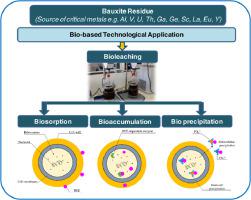Resources, Conservation and Recycling ( IF 13.2 ) Pub Date : 2021-05-13 , DOI: 10.1016/j.resconrec.2021.105645 Sandeep Panda , Rachel Biancalana Costa , Syed Sikandar Shah , Srabani Mishra , Denise Bevilaqua , Ata Akcil

|
The growing demand for rare earth elements (REEs) confronted with a parallel supply risk, draws major interest to utilize secondary resources bearing higher REE content than the primary resources. The European Commission has recently identified bauxite as a Critical Raw Material (CRM). In particular, unexploited bauxite residues have invited due attention owing to their abundance (worldwide generation at 120 – 150 million tons/yr) and presence of REEs (0.5 - 1.7 kg/ton) and scandium (Sc) in particular, with Fe: 14–45%, Al: 5–14%, Si: 1–9%, Na: 1–6% and Ti: 2–12%. Nevertheless, it has also to be taken into consideration that higher amassing of this waste is turning into a global concern due to its hazardous impacts and disposal issues owing to its high alkalinity, fine particle size and metal content. Industrial valorization of REEs from stockpiled bauxite residues could possibly unlock approximately a 4.3 trillion-dollar economy globally. This review foresees bauxite as a potential resource for REEs and identifies the problems associated with disposal of bauxite residues. Considering the recycling potential of bauxite residues for supplying valuable metals for technology, biotechnology is seen as a promising alternative to the conventional methods. Comprehensive details including role and challenges of biotechnology in green recovery of REEs from bauxite residues, their scale-up and environmental issues are critically discussed. Furthermore, w.r.t. the bauxite residues, the REE market potential is presented with discussions into future prospects, following the current impact of COVID-19 pandemic on the demand and supply of REE to industrial sectors.
中文翻译:

生物技术趋势和市场对铝土矿渣(红泥)中稀土元素回收的影响–综述
稀土元素(REE)的需求不断增长,面临着平行的供应风险,因此引起人们的极大兴趣,即要使用比REE含量更高的REE含量的二次资源。欧盟委员会最近已将铝土矿确定为关键原料(CRM)。特别是,未开采的铝土矿残留物由于其含量丰富(全球产量为120-1.5亿吨/年),特别是稀土元素(0.5-1.7千克/吨)和scan(Sc)的存在而受到关注,其中Fe:14 –45%,Al:5–14%,Si:1–9%,Na:1–6%,Ti:2–12%。然而,还必须考虑到,由于其高的碱度,细粒度和金属含量,由于其有害的影响和处置问题,这种废物的更高质量正成为全球关注的问题。从储存的铝土矿残渣中获取工业价值的稀土可能释放全球约4.3万亿美元的经济。这篇评论预计铝土矿将成为稀土的潜在资源,并确定与铝土矿残留物处置相关的问题。考虑到铝土矿残渣的回收潜力,可为技术提供有价值的金属,因此生物技术被认为是传统方法的有前途的替代方法。全面讨论了生物技术在从铝土矿残留物中绿色回收稀土的作用和挑战,其规模扩大和环境问题等方面的全面细节。此外,这篇评论预计铝土矿将成为稀土的潜在资源,并确定与铝土矿残留物处置相关的问题。考虑到铝土矿残渣的回收潜力,可为技术提供有价值的金属,因此生物技术被认为是传统方法的有前途的替代方法。全面讨论了生物技术在从铝土矿残留物中绿色回收稀土的作用和挑战,其规模扩大和环境问题等方面的全面细节。此外,这篇评论预计铝土矿将成为稀土的潜在资源,并确定与铝土矿残留物处置相关的问题。考虑到铝土矿残渣的回收潜力,可为技术提供有价值的金属,因此生物技术被认为是传统方法的有前途的替代方法。全面讨论了生物技术在从铝土矿残留物中绿色回收稀土的作用和挑战,其规模扩大和环境问题等方面的全面细节。此外,严格讨论了它们的扩大规模和环境问题。此外,严格讨论了它们的扩大规模和环境问题。此外,WRT铝土矿残渣,稀土元素的市场潜力,提出与讨论到未来的前景,以下COVID-19的电流冲击对稀土元素的工业部门的需求和供给的流行。



























 京公网安备 11010802027423号
京公网安备 11010802027423号